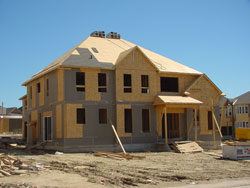 Starting January 2012, the world of home building in Ontario will change the way it already has in British Columbia, and the same way it will eventually change across Canada. The issue is new building code legislation that’s designed to increase the energy efficiency of new homes, but the actual outcome depends on your ability as a new home buyer to ask about and respond to an obscure but crucial technical issue.
Starting January 2012, the world of home building in Ontario will change the way it already has in British Columbia, and the same way it will eventually change across Canada. The issue is new building code legislation that’s designed to increase the energy efficiency of new homes, but the actual outcome depends on your ability as a new home buyer to ask about and respond to an obscure but crucial technical issue.
What is E80?
Dubbed E80, this new standard rates homes on the same sort of broad EnerGuide scale that’s now applied to appliances, electronics and other things. That’s where the “E” in the name comes from. The 80 refers to a percentage scale where 100 describes a home that produces as much energy as it consumes. This is called a zero energy home in the business, and though it might seem technically impossible, it’s actually entirely achievable. Zero energy new homes have been built and zero energy is the ultimate goal that our governments are leading the industry towards. E80 was intended to be an interim step in this direction, with E80 homes consuming about 30% less energy than new houses built to previous standards. But whether or not the new home you buy or have built delivers this level of performance isn’t guaranteed. That’s because there may be two kinds of E80-based homes on the market depending on where you live, and the difference could have a huge impact on the energy bills you pay.
Demystifying New Energy Efficiency Requirements
When E80 code standards were originally proposed, it included a requirement that each and every new home be physically tested for air leakage. The loss of heated and cooled air is an important part of how much energy a building consumes, and air leakage is tested by temporarily pressurizing the interior space using an electric blower installed over an exterior door. This loss of pressurized air is measured, and the number used to determine how many complete air changes occur per hour out of the entire home.
Although blower door testing is still an option for builders, the home building industry lobby led to a concession that’s quite significant. There are now two ways new homes can meet the new building code requirements:
- Actual performance testing as completed on each and every home
- A construction recipe approach that replaces testing with a recipe list of building features that should, in theory, yield E80 results
The second is called the prescriptive approach, and the thing that makes me concerned is the fact that these homes are assumed to have a low level of air leakage,  even without a blower door test. It’s like buying a new car design that’s supposed to get 50 mpg, though no one has actually measured it.
even without a blower door test. It’s like buying a new car design that’s supposed to get 50 mpg, though no one has actually measured it.
Besides being crucial for energy performance, air leakage varies tremendously depending on how carefully a home was built. Nowhere is this more clearly proven than in testing completed by ecoEnergy, a branch of the federal government. According to measurements taken from more than 8000 new homes built over the last decade, more than half failed to achieve the necessary air tightness performance.
So what does all this potential variation in air tightness mean if you’re planning to buy a new home next year? First, recognize that performance-tested E80 homes may be significantly better than those following the prescriptive method of construction. Without physical testing, how will you know? And second, while it remains to be seen how many builders will opt for either the prescriptive or performance path as code changes sweep across the country, any home can be assessed for air leakage with a blower door test after it’s built. If you’ve got your eye on an E80 home built to prescriptive standards (or any other home for that matter), you can always request that it be tested for air leakage before committing to buy. Cost for testing is about $300 and will show you exactly what you’re getting.
Although stud frame walls have long been the mainstay of new home construction, it’s technically challenging to build a wood frame that holds air as well as the tightening code standards demand. Besides offering a chance for Canadians to own more efficient homes, the E80-based code will also boost alternatives to stud frame construction that make it easier to build tight.
Consumers don’t know enough to ask for E80 homes, and the home building industry is never crazy about building to higher standards unless it has to. Despite the fact that no political hay is to be made from E80 – and despite the less-than-perfect state of the upcoming code standards – we’re still seeing momentum for E80 moving across the country. And as long as you know what to ask about, it’s a pretty good thing.



